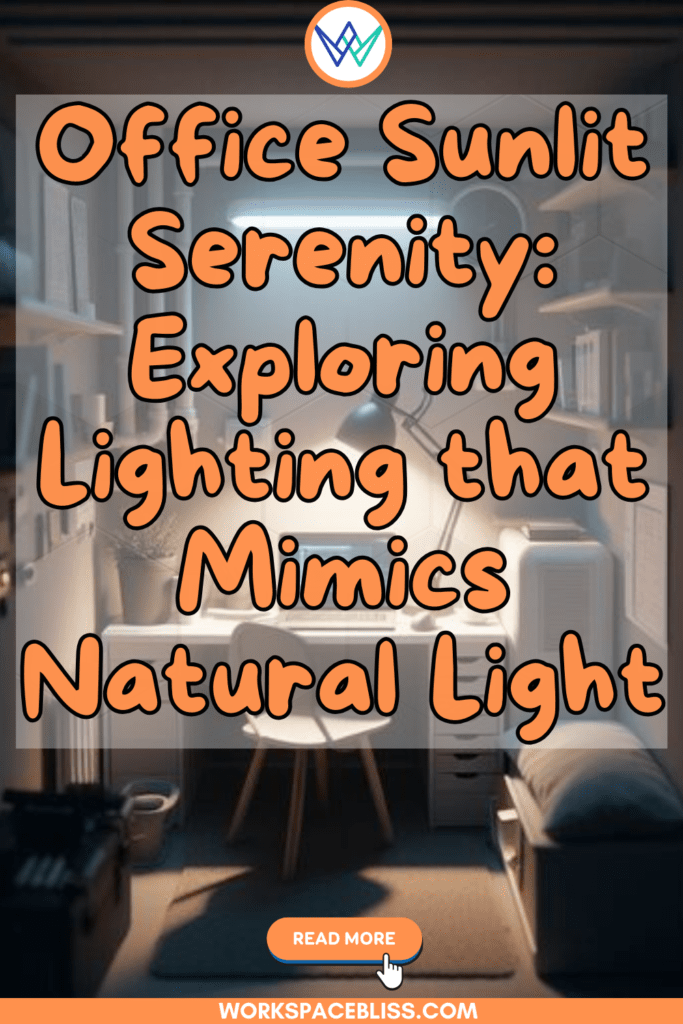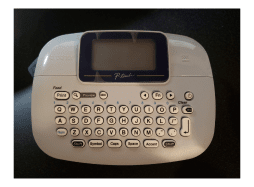Are you sitting in a dull, dark, lifeless office each day and need to find office lighting that mimics sunlight? This is a challenge for many out there who work in a cubicle , an office with no windows, or a home office without any sunlight available.
In this article, I will explore what lighting that simulates sunlight is, how it works, its advantages and disadvantages compared to natural sunlight, how to choose the right lighting for your office, and answer some frequently asked questions about this type of lighting.
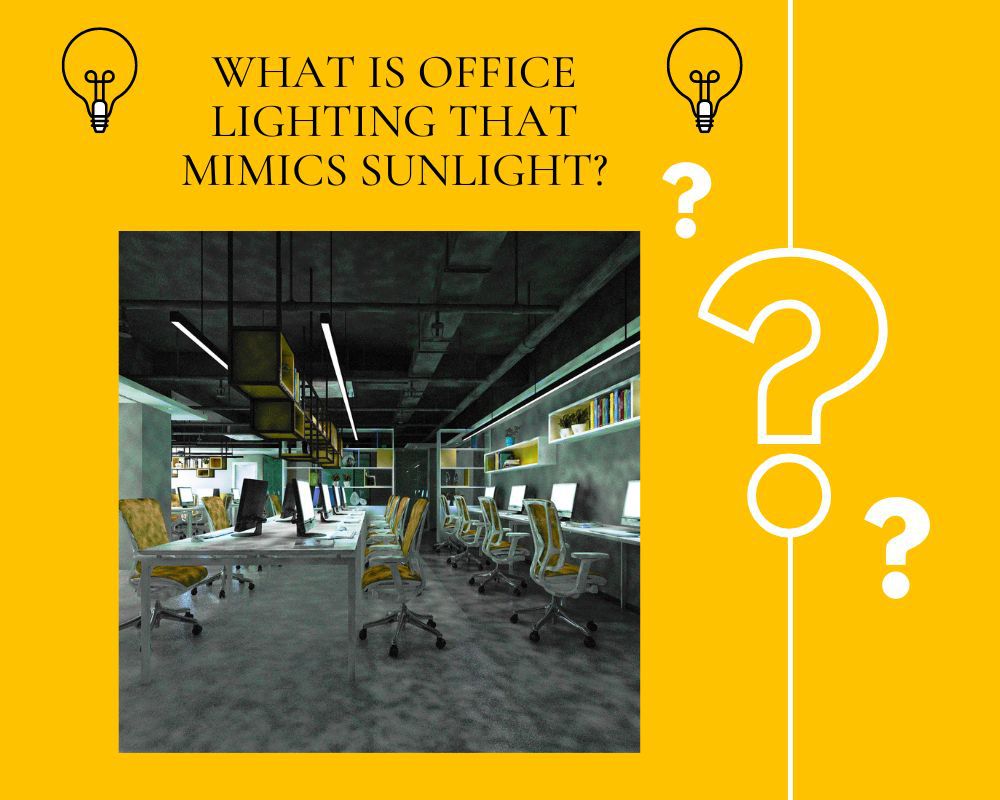
Sufficient workplace lighting is essential for creating a productive, comfortable, and happy work environment. In recent years, there has been a growing interest in natural lighting that simulates daylight in the workplace.
Light that mimics sunlight has been shown to offer a number of benefits, including productivity increases, reduced absenteeism, enhanced employee morale, and boosting energy in workplace settings.
However, not all workplaces are fortunate enough to have natural sunlight access, so there is certainly a need to mimic the wondrous lighting that we gain from the sun.
What is Office Lighting That Mimics Sunlight?
Office lighting that mimics sunlight is artificial lighting designed to replicate the natural sunlight spectrum. This lighting is achieved using LED technology, which emits light that is similar to natural sunlight, which includes the blue light that is known to be beneficial to our circadian rhythm.
Light that simulates sunlight typically features a high color rendering index (CRI) and a color temperature of around 5000K, which is similar to the color temperature of daylight.
Color temperatures which are greater than 5000K are designated as cool colors while color temperatures in the 2700K – 3000K range are considered warm colors.
The lighting fixtures for light that simulates sunlight are typically dimmable, allowing for greater control over the levels of light in the workplace.
Advantages of Lighting that Simulates Daylight
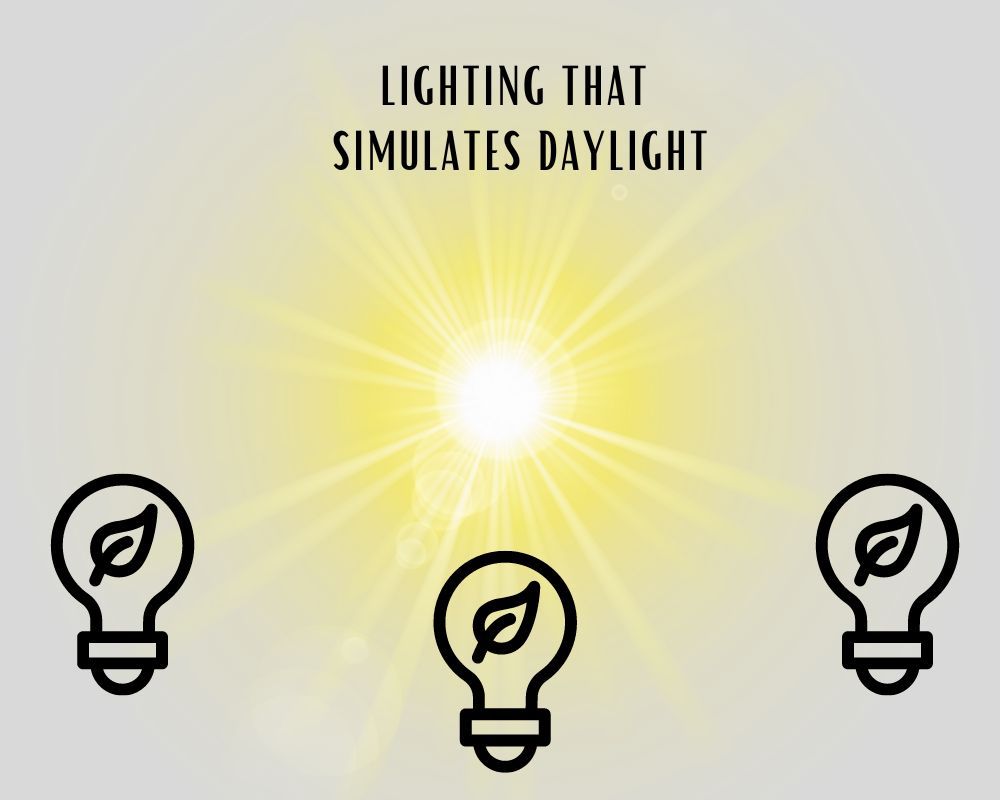
One of the most significant advantages of sunlight-mimicking lighting is that it can aid in regulating our circadian rhythm. Our bodies reply on exposure to natural sunlight to maintain a healthy sleep-wake cycle.
Without it we can experience a range of various health problems, including insomnia, depression, and increased risk of chronic diseases.
By using light that mimics sunlight, we can help to regulate our circadian rhythm, which in turn can help to improve our sleep quality, boost our mood, and increase our overall well-being.
This is particularly important for people who work long hours indoors, as they may not get enough exposure to natural sunlight during the day.
Sunlight-simulating light can also help to reduce fatigue and eye strain, which are common problems associated with traditional fluorescent lighting that you find in older office buildings.
This is because sunlight-mimicking lighting provides a more natural and balanced light, reducing glare and improving contrast.
Finally, light that simulates sunlight can also help to reduce energy costs. LED lighting is highly energy-efficient and can consume up to 80% less energy than conventional incandescent bulbs, which can result in serious savings for businesses in the long run.
Indoor Lighting that Emulates Sunlight – Popular Brands and Models
There are several popular brands and models of light that simulates sunlight available on the market, each with its unique features and benefits. Some of the most popular brands include the following.
- Philips Hue White Ambiance A19 Starter Kit – Light Bulbs that Mimic Sunlight
- Circadian Optics Lumine Light Therapy Lamp – Therapy Lamp that Simulates Sunlight
- Verilux HappyLight Therapy Lamp – Sunlight Imitating Lamp to Combat Seasonal Affective Disorder
- Dyson Lightcycle Morph Desk Lamp – Desk Lamp that Mimics Sunlight
- AFROG Multifunctional LED Desk Lamp – Desk Light that Simulates Sunlight
The popular brands listed above can be seen below. Click on the image or link for more details.
How Does Light that Simulates Sunlight Compare to Natural Sunlight?
While sunlight-mimicking lighting can provide many of the benefits of natural sunlight, it will never match all of them. Natural sunlight offers a range of health benefits beyond the spectrum of visible light, including the production of vitamin D, which is clearly important for bone health and immune function.
Also, natural sunlight is changing constantly throughout the day, with varying levels of intensity and color temperature. While light that simulates sunlight can provide a similar spectrum of light, it cannot specifically replicate the dynamic changes that come with natural sunlight.
Pros and Cons of Using Lighting that Mimics Sunlight Instead of Natural Sunlight
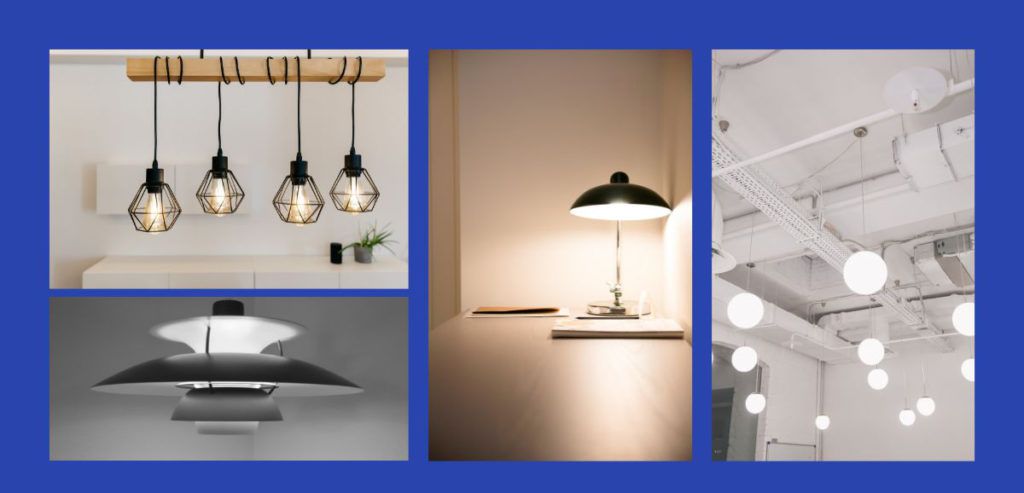
One of the main advantages of using sunlight-mimicking lighting instead of natural sunlight is that it is available at all times, regardless of weather or time of day.
Additionally, sunlight-simulated light is also a good option for workplaces that have limited access to natural sunlight, such as those located in high-rise buildings or in areas with poor weather conditions.
On the other hand, using sunlight-mimicking lighting instead of natural sunlight means that employees may not get enough vitamin D, which can have negative health consequences.
Additionally, while sunlight-mimicking lighting can replicate the spectrum of natural sunlight, it cannot replicate the warmth or beauty of natural sunlight, which most people find important for their well-being.
How to Balance Between Natural Sunlight and Lighting that Simulates Sunlight
The ideal balance between natural sunlight and sunlight-mimicking lighting will depend on the specific needs and circumstances of the workplace.
In general, it is recommended to prioritize natural sunlight whenever possible, by positioning workstations near windows or providing outdoor break areas. Oftentimes in the workplace you need to work in an office with a door to have access to a window.
One way to resolve this issue is to work with a workplace design consultant who will not only consider communication between departments into the design but also availability of natural light to as many employees as possible.
When natural sunlight is not available, or when additional lighting is needed, sunlight-mimicking lighting can be a good option. It is recommended to use lighting fixtures that can be adjusted according to the time of day, to simulate the natural changes in light levels and color temperature.
How to Choose the Right Lighting that Simulates Daylight for Your Office
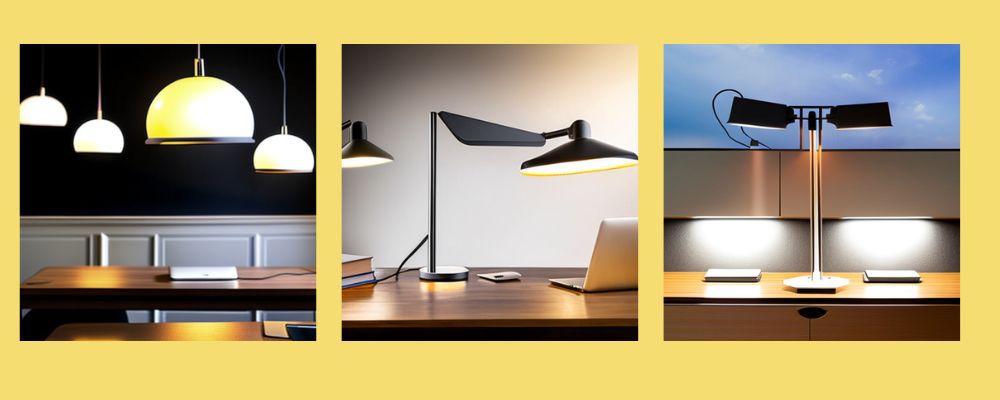
When choosing any type of lighting for your office, there are several factors to consider.
- Color Temperature: Look for lighting fixtures with a color temperature of around 5000K, which is similar to the color temperature of natural daylight.
- Color Rendering Index (CRI): Choose lighting fixtures with a high CRI, which means that the colors of objects will appear more natural.
- Dimmability: Look for lighting fixtures that can be dimmed, to allow for greater control over the lighting levels.
- Energy Efficiency: Choose LED lighting fixtures that are energy-efficient, to save on energy costs. This is a huge consideration for an individual and even more so in an office building.
- Design: Consider the design of the lighting fixture, and choose one that complements the aesthetic of your office and will functionally make sense for the space.
When evaluating different brands and models of sunlight-mimicking lighting, it is also a good idea to read reviews from other users and to compare prices.
Recommendations on Where to Purchase Sunlight-Simulated Lighting
Lighting that emulates sunlight can be purchased from a variety of retailers, including online stores as well as brick-and-mortar retailers. Some popular online stores that offer a range of lighting options include Amazon, Home Depot, Wayfair, and Lowes.
Office Lighting that Mimics Sunlight – A Recap
Office lighting that mimics sunlight can provide numerous benefits for workplaces that do not have access to the glorious benefits of natural sunlight. By reproducing or replicating the spectrum of natural sunlight, this type of lighting can help to regulate our circadian rhythm, reduce eye strain and fatigue, and significantly save on company energy costs.
Lighting found in a home office is extremely important especially if it is a windowless office. There are numerous home office lighting ideas and accessories available to set yourself up for success at home.
While it is not a perfect substitute, light that mimics daylight can be a good option for workplaces that have limited access to natural sunlight, or when additional lighting is needed.
If you choose the right sunlight-mimicking lighting for your office, you can create a brighter, more productive, and more comfortable workspace for your employees.
It is important to be cognizant of the fact that natural sunlight should always be prioritized whenever possible, as it provides numerous health benefits that cannot be replicated by artificial lighting.
However, when natural sunlight is not available, or when additional lighting is needed, lighting that simulates daylight can be a great alternative.
Overall, the benefits of office lighting that simulates sunlight are numerous, and it is a great way to create a healthier and more productive workspace for your employees.
If you decide to adhere to the recommendations detailed in this article, you can not only choose the right lighting fixtures for your office, you can create a space that is both comfortable and functional for your employees.
At a minimum you should find an LED desk lamp that mimics sunlight. You’ll have it on throughout the day and it will help properly illuminate your formerly-dark workspace. A couple have been identified in this article and are certainly worth consideration.
So, if you’re considering switching to indoor lighting that mimics sunlight in your own office, not only will it provide numerous health benefits, but it can also lead to increased productivity, reduced energy costs, and a brighter and more comfortable workspace for your employees.
Frequently Asked Questions About Indoor Lighting that Mimics Sunlight
Is sunlight-mimicking lighting safe for the eyes?
Yes, sunlight-mimicking lighting is perfectly safe for the eyes. In fact, it can help to reduce fatigue and eye strain, as it provides a more natural and balanced light.
Can light that mimics daylight help with seasonal affective disorder (SAD)?
Yes, sunlight-mimicking lighting can be used as a treatment for seasonal affective disorder (SAD), which is a type of depression that is related to changes in seasons. A therapy lamp, also known as an energy lamp can be utilized in a dark office or any dimly-lit space to replicate the light of the sun.
Can indoor lighting that mimics sunlight be used in other settings besides the office?
Yes, sunlight-simulated lighting can be used in a variety of settings, including homes, schools, nursing homes, hospitals, and other healthcare-related facilities. Anywhere there is a lack of natural sunlight can certainly benefit from lighting that simulates the spectrum of natural sunlight.
What to Read Next:
- How to Decorate an Office with No Windows in 10 Simple Steps
- What to Bring on Your First Day of Work – 22 Essential Items
- 30 Good Excuses to Work from Home [For a Day or Permanently]
- 25 Clear-Cut Signs Your Boss is Threatened By You
- How To Make the Workday Go By Faster – 35 Top Tips
Bob has been blogging for over 20 years and has been an office and cubicle dweller for more than 35 years. He has been featured in numerous online publications such as US News and World Report, Bustle, and Work Awesome (you can read his articles here). He created the popular office website CubicleBliss in January 2011 and rebranded it as WorkspaceBliss in April 2020.
In the office he’s been an IT Manager, Applications Engineer, Systems Analyst, Software Project leader, and Programmer Analyst in his long career. He’s a Certified Microsoft Professional and possesses a Masters of Science degree and two Bachelor of Science degrees, one of those in Informational Technology.
During his career he has worked in the office full-time, as a hybrid remote worker, and has worked from home permanently.
